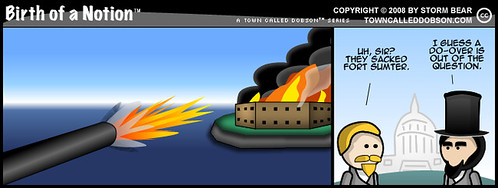 click to enlarge Several forts had been constructed in the harbor, including Fort Sumter and Fort Moultrie. Fort Moultrie was the oldest and was the headquarters of the garrison. However, it had been designed essentially as a gun platform for defending the harbor, and its defenses against land-based attacks were feeble; during the crisis, the Charleston newspapers commented that sand dunes had grown up against the walls in such a way that the wall could easily be scaled. When the garrison began clearing away the dunes, the papers objected. Fort Sumter, by contrast, dominated the entrance to Charleston Harbor and was thought to be one of the strongest fortresses in the world once its construction was completed; in the autumn of 1860 work was nearly done, but the fortress was thus far garrisoned by a single soldier, who functioned as a lighthouse keeper. However, it was considerably stronger than Fort Moultrie, and its location on a sandbar prevented the sort of land assault to which Fort Moultrie was so vulnerable. Under the cover of darkness on December 26, 1860, Anderson spiked the cannons at Fort Moultrie and moved his command to Fort Sumter. South Carolina authorities considered this a breach of faith and demanded that the fort be evacuated. At that time President James Buchanan was still in office, pending Lincoln's inauguration on March 4, 1861. Buchanan refused their demand and mounted a relief expedition in January 1861, but shore batteries fired on and repulsed the unarmed merchant ship, Star of the West. The battery that fired was manned by cadets from The Citadel, who were the only trained artillerists in the service of South Carolina at the time. Following the formation of the Confederacy in early February, there was some internal debate among the secessionists as to whether the capture of the fort was rightly a matter for the State of South Carolina or the newly declared national government in Montgomery, Alabama. South Carolina Governor Francis W. Pickens was among the states' rights advocates who felt that all of the property in Charleston harbor had reverted to South Carolina upon that state's secession as an independent commonwealth. This debate ran alongside another discussion as to how aggressively the properties—including Forts Sumter and Pickens—should be obtained. Jefferson Davis, like his counterpart in Washington, D.C., preferred that his side not be seen as the aggressor. Both sides believed that the first side to use force would lose precious political support in the border states, whose allegiance was undetermined; prior to Lincoln's inauguration on March 4, five states had voted against secession, including Virginia, and Lincoln openly offered to evacuate Fort Sumter if it would guarantee Virginia's loyalty. In March, Brigadier General P.G.T. Beauregard took command of South Carolina forces in Charleston; on March 1, Davis had appointed him the first general officer in the armed forces of the new Confederacy, specifically to take command of the siege. Beauregard made repeated demands that the Union force either surrender or withdraw and took steps to ensure that no supplies from the city were available to the defenders, whose food was running out. He also increased drills amongst the South Carolina militia, training them to operate the guns they manned. Ironically enough, Anderson had been Beauregard's artillery instructor at West Point; the two had been especially close, and Beauregard had become Anderson's assistant after graduation. Both sides spent the month of March drilling and improving their fortifications to the best of their abilities. By April 4, President Lincoln, discovering that supplies in the fort were shorter than he had previously known, and believing a relief expedition to be feasible, ordered merchant vessels escorted by the United States Navy to Charleston. On April 6, 1861, Lincoln notified South Carolina Governor Francis W. Pickens that "an attempt will be made to supply Fort Sumter with provisions only, and that if such attempt be not resisted, no effort to throw in men, arms, or ammunition will be made without further notice, [except] in case of an attack on the fort." In response, the Confederate cabinet, meeting in Montgomery, decided on April 9 to open fire on Fort Sumter in an attempt to force its surrender before the relief fleet arrived. Only Secretary of State Robert Toombs opposed this decision: he reportedly told Jefferson Davis the attack "will lose us every friend at the North. You will wantonly strike a hornet's nest. ... Legions now quiet will swarm out and sting us to death. It is unnecessary. It puts us in the wrong. It is fatal." The Confederate Secretary of War telegraphed Beauregard that if he were certain that the fort was to be supplied by force, "You will at once demand its evacuation, and if this is refused proceed, in such a manner as you may determine, to reduce it." Beauregard dispatched aides to Fort Sumter on April 11 and issued their ultimatum. Anderson refused, though he reportedly commented, "Gentlemen, if you do not batter the fort to pieces about us, we shall be starved out in a few days." Further discussions after midnight proved futile. At 3:20 a.m., April 12, 1861, the Confederates informed Anderson that they would open fire in one hour. At 4:30 a.m., a single mortar round fired from Fort Johnson exploded over Fort Sumter, signaling the start of the bombardment from 43 guns and mortars at Fort Moultrie, Fort Johnson, and Cummings Point. Edmund Ruffin, a notable secessionist, had traveled to Charleston in order to be present for the beginning of the war, and was present to fire the first shot at Sumter after the signal round. Anderson withheld his fire until 7:00 a.m., when Capt. Abner Doubleday fired a shot at the Ironclad Battery at Cummings Point. But there was little Anderson could do with his 60 guns; he deliberately avoided using guns that were situated in the fort where casualties were likely. Unfortunately, the fort's best cannons were mounted on the uppermost of its three tiers, where his troops were most exposed to enemy fire. The fort had been designed to hold out against a naval assault, and naval warships of the time did not mount guns capable of elevating to fire over the walls of the fort; however, the land-based cannons manned by the South Carolina militia were capable of landing such indirect fire on Fort Sumter. Fort Sumter's garrison could only safely fire the guns on the lower levels, which themselves, by virtue of being in stone emplacements, were largely incapable of indirect fire that could seriously threaten Fort Moultrie. Moreover, although the Federals had moved as much of their supplies to Fort Sumter as they could manage, the fort was quite low on ammunition, and was nearly out at the end of the 34-hour bombardment. The shelling of Fort Sumter from the batteries ringing the harbor awakened Charleston's residents (including diarist Mary Chesnut), who rushed out into the predawn darkness to watch the shells arc over the water and burst inside the fort. The bombardment lasted through the night until the next morning, when a shell hit the officers' quarters, starting a serious fire that threatened the main powder magazine. The fort's central flagpole also fell. During the period the flag was down, before the garrison could improvise a replacement, several Confederate envoys arrived to inquire whether the flag had been lowered in surrender. Anderson agreed to a truce at 2:00 p.m., April 13, 1861. Terms for the garrison's withdrawal were settled by that evening and the Union garrison surrendered the fort to Confederate personnel at 2:30 p.m., April 14. The soldiers were safely transported back to Union territory by the U.S. Navy squadron whose anticipated arrival as a relief fleet had prompted the barrage. No one from either side was killed during the bombardment, with only five Union and four Confederate soldiers severely injured. During the 100-gun salute to the U.S. flag—Anderson's one condition for withdrawal—a pile of cartridges blew up from a spark, killing one soldier (Private Daniel Hough) and seriously injuring the rest of the gun crew, one mortally (Private Edward Galloway); these were the first fatalities of the war. The salute was stopped at fifty shots. Anderson lowered the Fort Sumter Flag and took it with him to the North, where it became a widely known symbol of the battle, and a rallying point for supporters of the Union. The bombardment of Fort Sumter was the first military action of the American Civil War. Following the surrender, Northerners rallied behind Lincoln's call for all of the states to send troops to recapture the forts and to preserve the Union. With the scale of the rebellion apparently small so far, Lincoln called for 75,000 volunteers for 90 days. For months before that, several Northern governors had discreetly readied their state militias; they began to move forces the next day. The ensuing war lasted four years, effectively ending in April 1865, with the surrender of General Robert E. Lee's Army of Northern Virginia. Charleston Harbor was completely in Confederate hands for the four-year duration of the war, a hole in the Union naval blockade. Union forces retook the fort just days after Lee's surrender and the collapse of the Confederacy. On April 14, 1865, four years to the day after lowering the Fort Sumter Flag in surrender, Anderson (by then a major general, although ill and in retired status) raised it over the fort again. Two of the cannons used at Fort Sumter were later presented to Louisiana State University by General William Tecumseh Sherman, who was president of the university before the war began. Birth Of A Notion Disclaimer SPECIAL REQUEST FOR TCD FANS: The San Francisco Chronicle is pondering the addition of new cartoons for their paper - a process that seems to be initiated by Darren Bell, creator of Candorville (one of my daily reads - highly recommended). You can read the Chronicle article here and please add your thoughts to the comments if you wish. If anything, put in a good word for Darren and Candorville. I am submitting Town Called Dobson to the paper for their consideration. They seem to have given great weight to receiving 200 messages considering Candorville. I am asking TCD fans to try to surpass that amount. (I get more than that many hate mails a day, surely fans can do better?) This is not a race between Darren and I, it is a hope that more progressive strips can be represented in the printed press of America. So if you read the San Francisco Chronicle or live in the Bay Area (Google Analytics tell me there are a lot of you), please send your kind comments (or naked, straining outrage) to David Wiegand at his published addresses below. If you are a subscriber, cut out your mailing label and staple it to a TCD strip and include it in your letter. candorcomment@sfchronicle.com or David Wiegand Executive Datebook Editor The San Francisco Chronicle 901 Mission St. San Francisco, CA 94103 |
Monday, April 28, 2008
Black History: First Shots of the Civil War
Posted by
Storm Bear
at
9:33 AM
![]()
Labels: cartoons, civil war, comics, fort sumter, slavery, south carolina, webcomics
Subscribe to:
Post Comments (Atom)








0 comments:
Post a Comment